Real Alcazar is the Royal Palace of Seville, a magnificent complex of patios and halls in different architectural styles, from Mudéjar to Gothic. The heart of the complex is the Palace of King Pedro I, who constructed his royal residence in 1364 on the site of a Moorish palace.
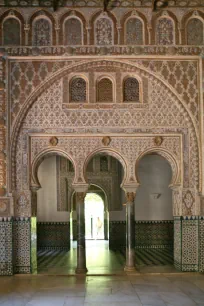
History
Soon after the Almohades, a Moorish dynasty, gained control of Seville in 1161, they embarked on a building frenzy. They constructed a number of baths, towers, a lavish grand mosque and a fortress-like palace known as the Al-Muwarak (the Blessed).
In 1364, after the Reconquista – the reconquest of Moorish Spain by Christians – King Pedro I commissioned the construction of a new palace, the Palacio Pedro I, at the site of the Al-Muwarak. Craftsmen from across Andalusia created a magnificent interior in Mudéjar style, arranged around a number of patios. Over the years, other monarchs kept expanding the palace, resulting in a diverse complex with different architectural styles. The top floor of the palace is still actively used by the Royal Family.
Touring the Palace
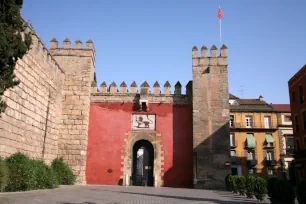
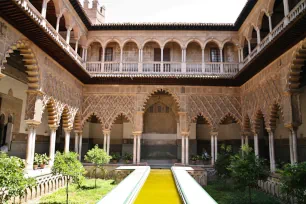
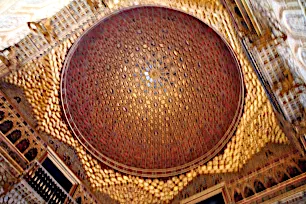
The palace can be entered from the Plaza del Triunfo through the Puerta del León or Lion’s Gate. The large gate, set in a massive crenelated defensive wall, is decorated with an azulejo (ceramic tile work) depiction of a heraldic lion.
The gate leads to the Lion’s Patio. Ahead, passing through a triple arch, is another courtyard, the Patio de la Montería. It is named after the hunters (monteros) who met here with the King before they went out hunting. The patio is bordered by the Palacio Pedro I, the original palace of King Pedro. Its facade is decorated in Mudéjar style with lobed arched windows and blind arches.
Once inside, you arrive onto the Patio de las Doncellas, the main courtyard of the palace. This was the center of public life in the palace of Pedro I. From the patio, which is named after the ladies (doncellas) who spent much of their time here, you can reach several halls: the Hall of the Kings, the Hall of Charles V and the Hall of the Ambassadors.
The latter was used for ceremonial events. Locally known as the Salón de Embajadores, it is the most magnificent part of the palatial complex. Intricately decorated archways with horseshoe arches give access to the hall which is covered with a stunning dome, created in 1389 in a Moorish style by Diego Ruiz, a local craftsman. The gilded dome is made of interlaced wood. Just below the dome is a frieze with portraits of Spanish kings.
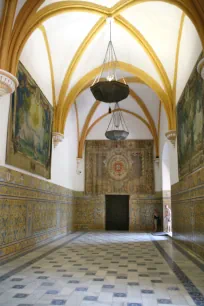
Private life in the Palace of Pedro I revolved around the Patio de las Muñecas, which leads to the bedrooms and private halls. The small hall is enclosed by a gallery with marble columns and lobed arches. The name of the Patio de las Muñecas – Patio of the Dolls – is derived from four small heads that decorate one of the arches.
A complete different architectural style can be found in the Salones de Carlos V, where a Gothic vaulted hall is decorated with tapestries and azulejos.
Another interesting hall, situated west of the Patio de la Montería, is the Hall of the Admirals (Cuarto del Admirante). Seafarers and navigators planned their journeys to the Americas here, in the Casa de la Contratación. A retable in the small chapel of the Casa de la Contratación is said to depict Christopher Columbus next to the Virgin Mary.
The Gardens
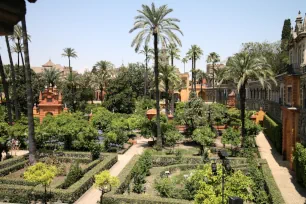
A visit to the Royal Alcazar also allows entry into the royal gardens. The expansive area is divided into a number of separate gardens, some of which are terraced. They are laid out in a number of diverse styles, including French, Italian and Arab. The gardens bear names such as the Garden of the Dance, Garden of the Ladies and the Garden of the Prince.
The first area you’ll encounter is the Garden of the Pond (Jardín del Estanque). Here, a large arch overlooks a rectangular basin, known as the Pond of Mercury. At the center of the pond is a small fountain with a statue of Mercury, the messenger of the Gods. The arch is connected to a gallery – the Galeria del Grutesco – which was once part of the original Moorish palace.
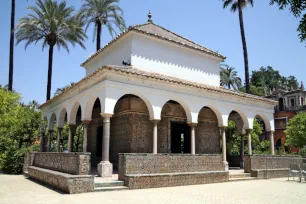
From the pond you have a view over a walled-in section of the garden, laid out in a formal style. To the right of the pond are a number of smaller terraced gardens, all connected to each other via gates and small staircases. The gardens are decorated with fountains, grottos, a labyrinth and even a small artificial mountain. The Garden of the Dance is decorated with benches covered with azulejos. There are also a number of pavilions in the Royal Gardens, such as the beautiful arcaded Pavilion of Carlos V, which can be found in the Jardín de la Alcoba (Garden of the Alcove).
- Next: Cathedral
- More Sights & Attractions in Seville
